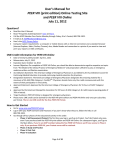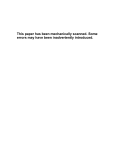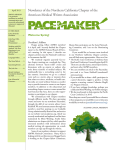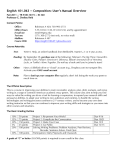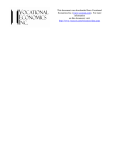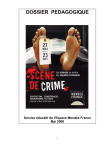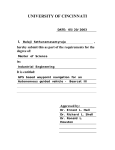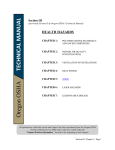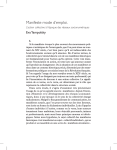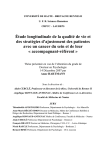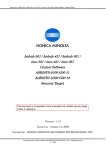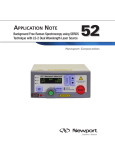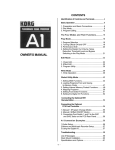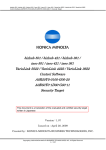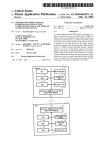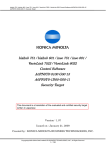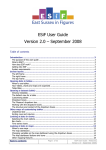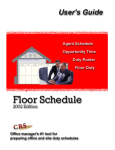Download August 2015 - (AMWA), Northern California Chapter
Transcript
August 2015 AMWA's MISSION is to promote excellence in medical communication and to provide educational resources in support of that goal. Newsletter of the Northern California Chapter of the American Medical Writers Association IN THIS ISSUE Highlights . . . . . . . . . 1 Letter from Our Chapter President. . . .2 Chapter Board of Directors . . . . . . . . . . 2 Summer Social. . . . . . 3 Help! Email Ate My File. . . . . . . . . . . .3 Upcoming Events. . . .4 The Word Witch: Decimal-Alignment in Tables. . . . . . . . . . . . .6 Don't Wreck Your Bod, Part 1: The "Epidemic" That Is Killing Medical Writers! . . . . . . . . . . . 8 Don't Wreck Your Bod, Part 2: Stand Up to Write . . 10 Planning for the 2016 Pacific Coast Conference: Survey Results . . . . . 12 Planning for the 2016 Pacific Coast Conference: Summary of Open Sessions at 1-Day PCC in San Diego . . . . . . 14 Upate: Medical Writer Certified (MWC™) Credential . . . . . . . . 15 Upate: CORE—Clarity and Openness in Reporting: E3-Based: A User Manual to Benefit CSR Writers . . . . . . .15 HIGHLIGHTS Letter from Chapter President An update from the AMWA national organization. Upcoming Events: Register for AMWA's 75th National Annual Conference This conference promises to be an exciting and productive event; register online now. Word Witch: Decimal-Alignment in Tables Great tips for how to align text in Word tables. Don't Wreck Your Bod: Parts 1 and 2 Your health may be more dependent on how you go through your workday than you think. These two articles describe why that may be so and what you can do about it. Planning for the 2016 Pacific Coast Conference The structure of the Pacific Coast Conference (PCC) is being re-evaluated: should it be a 1-day, 2-day, or 3-day conference? It depends on member preferences and chapter finances. Read about the results of the PCC survey, a summary of the 1-day PCC sponsored by the Pacific Southwest Chapter, and thoughts from attendees. Letter from President of Northern California AMWA Chapter By Arushi Sinha, PhD Arushi Sinha, president of our chapter, is also the president of Big Think Media, Inc., a publisher of a full range of specialized services Arushi led a roundtable, Getting Your Book Published, at the 2011 National Conference, and presented a talk at a recent AMWA Northern California meeting that focused on that topic. The Future of Medical Writing What do you think the future of medical writing looks like? Exciting times are ahead as AMWA National envisions its next 75 years. In honor of the 75th anniversary, the Executive Committee of the national organization has begun implementing a Strategic Planning Initiative. To kick off the discussions, President-Elect Lori Alexander identified some of the trends occurring in medical communication today, including: •Growth of Asian-based medical writing needs, specifically China and Japan. •In general, people are reading more items, but spending less time on any one item. •Growing use of infographics. •Emphasis of Plain Language Initiative. •Proliferation of medical apps. •Increasing use of health and medical social media. •Importance of patient-consumer in healthcare product development. Then, during a series of small-group activities at the meeting, the Board of Directors identified many strengths, opportunities, and aspirations. AMWA’s welcoming and diverse community and its broad range of high-quality, educational offerings were among the most frequently noted benefits of AMWA membership. If you would like to be involved in the leadership level discussions within AMWA, we invite you to join the Executive Board of AMWA Northern California Chapter. Please contact Arushi at [email protected] Northern California Chapter Board of Directors, 2014–2015 Elected Positions President: Arushi Sinha, PhD Vice President: Caren Rickhoff, BA Secretary: Barbara Arnoldussen, BSN, MBA Treasurer: Catherine Magill, PhD Program Chair: Barbara Boughton, BA Membership Liaison: Dennis Bittner, PhD Non-elected Positions Immediate Past President: Maggie Norris, BSc, ELS Jobs List Administrator: Dennis Bittner, PhD Chapter Committees Programming Committee: Barbara Boughton, BA; Maggie Norris, BSc, ELS Conference Planning Advisory Committee: Catherine Magill, PhD Communications Committee: Mary Wessling, PhD; Suzanne Canada, PhD; Myrna Faulds, BS; Caren Rickhoff, BA; Mayya Shveygert, PhD Page 2 • Pacemaker 8/2015 SUMMER SOCIAL: GREAT PICNIC! Our Northern California Chapter enjoyed a fun outdoor picnic social on Sunday, July 19th, at beautiful Central Park in San Mateo with lots of great food, interesting conversation, and lively networking. Thanks to everyone who made this event a reality, and to all who attended and brought dishes to share. Here’s a snapshot of several AMWA members who attended the picnic: •A writer who has spent 1 year at her first medical writing position. •A writer who just started a new position from an announcement on the AMWA job list. •A writer who has worked remotely with global clients for over 18 years. •A writer who is looking to make a transition from quality standards writing to more clinically focused work. These are just some of the personal stories that make medical writing such an amazing profession, and make participation in northern California AMWA so rewarding. We are planning more interesting events in the coming months, and if you would like to volunteer to help (the work is easy and it’s a great way to get to know other people in AMWA), please contact Barbara Boughton at barbara. [email protected] or at 510-219-0296. HELP—My Email Ate My File! By Mayya Shveygert, PhD Mayya Shveygert, who recently joined AMWA and is a member of the chapter's Communications Committee, is a postdoctoral fellow at the UCSF School of Medicine. Did something like this ever happen to you? 1. Opened a Word or Excel file from your webmail (for example, using Internet Explorer). 2. Made lots of changes and saved at least a few times. 3. Closed Word or Excel. 4. Tried to reopen the file but couldn’t find it. If so, our colleague Mayya Shveygert found the following quick tip online* that will save you much frustration. In Internet Explorer, when you click on an attachment you have two options: “open” and “save”. If you clicked “save”, you’d be fine. You will be able to save the file somewhere (for example, on the desktop) and continue working. The only way to lose the file is if you delete it or forgot where you saved it. If you clicked “open”, however, you’re entering zombie land. Word will show you the document (maybe after a warning that you opened a downloaded file). You will be able to edit and save the document regularly. But little do you know that you’re saving the file in a “safe zone” (technically, a system folder) used for files downloaded from the web. I call it zombie land because you have no idea that the files you’re saving will disappear the second you shut down Word. So, if you plan to edit the document that you downloaded, remember to always save your file to a specific location on your computer. *Excerpt from the blog entry by ODER RUN https://odedran.wordpress.com/2012/03/11/how-to-rescue-word-excel-or-other-attachment-files-opened-from-emailhotmail-or-outlook-web-access-that-were-opened-edited-and-saved-but-are-now-gone/ Pacemaker 8/2015 • Page 3 SAN AN TON IO UPCOMING EVENTS Celebrate AMWA's 75 th Annual Conference! AMWA Annual Meeting 30 September - 3 October 2015 San Antonio,Texas Grand Hyatt San Antonio 600 E Market Street, San Antonio, TX 78205 The AMWA Annual Conference is the ultimate resource for medical communicators around the world, offering educational and networking opportunities beyond compare in the field. The General Session Speakers will be Ivan Oransky and Jay Ingram. Make your reservations at the Grand Hyatt San Antonio today via the national AMWA website: http://www.amwa.org/events_annual_conference DESIGN YOUR PROGRAM This year, it’s easier than ever to find the program events of most interest to you and your professional goals. AMWA has expanded the use of topic area tracks to include all sessions and have developed Track Facts—simple reference guides that include sessions within each track. Track Facts, coupled with the Program at a Glance, will help you create your unique program quickly and easily. If you are working toward the Composition and Publication, Regulatory and Research, or Concepts in Science specialty certificate, you can use up to two “electives” to complete the requirements! Any AMWA credit workshop can be considered an “elective” and you have the opportunity to earn up to 4 workshop credits at conference. Helpful tips for first-time attendees are available on the North Central AMWA Chapter website: http://amwanorthcentral.org/chapter/?p=4179. TRACK FACTS FOCUS ON 12 AREAS: •Editing •Ethics •Freelance •Health and Medicine •PR/Marketing •Professional Development •Professional Relationships •Regulatory •Relevant Skills •Social Media and Technology •Writing for Lay Audiences •Writing for Professional Audiences Page 4 • Pacemaker 8/2015 UPCOMING EVENTS AMWA Chapter Events Checkout Pocket Trainings Online GREATER CHICAGO CHAPTER CONFERENCE Login to the AMWA national website and browse recordings of past webinars. "Pocket Trainings", mini tutorials, are also available. They cover a variety of topics useful to medical communication professionals (http://www. amwa.org/pocket_trainings). 24 July 2015 • Evanston, IL AMWA Online Offering WEBINAR: HOW TO BUILD A BUSINESS CASE AND INFLUENCE CHANGE 30 July 2015 • 1-2 PM Eastern Time http://www.amwa.org/online_offerings Note: Archived Members-Only OnDemand Webinars are available online through the AMWA national website. UPCOMING BOARD OF EDITORS IN LIFE SCIENCES (BELS) EXAMINATIONS Sunday, 30 August 2015, Brisbane, Queensland, Australia AMWA. Register by 9 August 2015 Wednesday, 30 September 2015, San Antonio, TX, AMWA. Register by 9 September 2015 Website: http://www.bels.org/index.cfm UPCOMING EUROPEAN MEDICAL WRITERS ASSOCIATION (EMWA) CONFERENCE The 41st EMWA Conference in The Hague, Netherlands will be held on the 5–7 November 2015 at The BelAir Hotel. PUBLICATION NEWS: NEW EDITION Scientific Style and Format:The CSE Manual for Authors, Editors, and Publishers Eighth Edition, 7 May 2014 By Council of Science Editors University Of Chicago Press Pacemaker 8/2015 • Page 5 THE WORD WITCH: DECIMAL-ALIGNMENT IN TABLES By Maggie Norris, BSc, ELS Maggie Norris, a past president of our AMWA chapter, is a long-time member of AMWA and currently serves on the Chapter's Programming Committee and is a member of the Chapter Board. In this tutorial, I show you how to decimal-align a column of numbers in a table. The Basics The concept of “place value” is basic to our civilization’s understanding of numbers: the value of, for example, a “6” is indicated by its horizontal position relative to other numerals that make up the entire number. As we all learned in first grade, the value of “6” in “63” is different from its value in “603.” For the past couple of millennia, scientists and mathematicians have been aligning columns of numbers by place value, often called “decimal alignment,” to facilitate comparison of the numbers. Word considers a table cell to be a paragraph and most of the tools for formatting table cells are accessed in the Paragraph dialog box and their keyboard equivalents. See Screenshot 1. Procedure The first step in applying decimal-alignment to a column of numbers is to left-align (left-justify) the cells (paragraphs) in the column. The next step is to remove all tabs in the cells. Then, add a decimal tab. Finally, adjust the position of the tab. Screenshot 1. Paragraph dialog box, Indents and Spacing tab. Word considers table cells to be paragraphs. As with text paragraphs, the tools for alignment, spacing, and line and page breaks are assigned in the Paragraph dialog box. Step 1. Left-align the cells. Select the range of cells to be decimal-aligned. In the Paragraph dialog box (Screenshot 1), apply left-alignment. Click OK to save the change and close the dialog box. Step 2. Remove existing tabs. With the range of cells still selected, call up Paragraph dialog box again and click Tabs (Screenshot 1) to open the Tabs dialog box (Screenshot 2). Click Clear all. Click OK to save the change and close the Tabs dialog box. Page 6 • Pacemaker 8/2015 Screenshot 2. Tabs dialog box. As with text paragraphs, tabs in table cells are set and modified in the Tabs dialog box. THE WORD WITCH: DECIMAL-ALIGNMENT IN TABLES (Concluded) Step 3. Add a decimal tab. With the cells still selected, call up the Tabs dialog box again. (This time, try the keyboard shortcut: Alt + t, o.) In the Alignment group, choose Decimal. In the Tab stop position field, enter a value to set a tab in each of the selected cells. (Suggestion: choose a value approximately half the width of the cells; ie, if the cell width is 1 inch, enter .5.) Click OK to save and close the Tabs dialog box. Note that it is not necessary to insert a tab character in the cells. Step 4. Adjust the position of the tab Look at the column or range of cells and see what you think (Screenshot 3). The numbers that contain a decimal point will be aligned with the decimal point at the tab position; ie, you could draw a straight vertical line connecting the decimal points. The numbers that do not contain a decimal point will be aligned as if they do have one. A decimal-tab icon is visible in the Ruler (Screenshot 4). Hint: display the Ruler: on the View tab, in the Show group, activate the Ruler checkbox. Screenshot 3. Table with decimalaligned columns. Numbers in both columns are decimalaligned, even though no decimal point is visible in the numbers in the left column. To adjust the position of the tab, either open the Tabs dialog box and change value in the Tab stop position field; or place the cursor on the tab icon in the ruler and move it. Note that the change will apply to selected cells. Screenshot 4. Ruler with decimal tab icon. To reposition the tab stop, capture the icon with the cursor and move right or left. Pacemaker 8/2015 • Page 7 Don't Wreck Your Bod! (Part 1) Editor's note: In our continuing series about how to improve our working environments to improve our health, two Northern California Chapter members have contributed articles: the first (Part 1) by Suzanne Canada focuses on the physical and social effects of prolonged sitting and social isolation; the second (Part 2) by Mary Wessling shows how on a limited budget and with some creativity, a writer can create a standing workstation. By Suzanne Canada, PhD Suzanne Canada, a past president of our AMWA Chapter, led the effort to bring our first chapter webinar to fruition and is a member of the Communications Committee. THE "EPIDEMIC" THAT IS KILLING MEDICAL WRITERS! “Medical Writers often toil for long hours in isolation.” These words, uttered by our past President Doug Haneline in an AMWA leadership meeting in Bethesda, Maryland, impressed upon me the essence of most medical writers’ work environments. It is evident that many of our work place environments and habits are unhealthy. Admittedly, the title of this article is misleading because researchers have not focused specifically on medical writers; however, I think that most of us would agree that medical writers are predisposed to spend long hours at their desks concentrating on long, detailed documents. The 2010 US census results found that 35.7% of working citizens spend more than 1 hour per day in a car!1 On top of that, more than 75% of us spend more than 4 hours sitting in a chair, according to a recent study on the health effects of sitting.2 We could improve on these two lifestyle factors: sedentary lifestyle (toiling long hours) and social isolation (spending too much time alone). The sedentary life is a high-risk life. A mountain of evidence is piling up about different ways that our sedentary lifestyles increase our mortality risk. One review of literature from 1996 until 2011,3 concluded that not getting exercise is linked to not only obesity and heart disease, but also cancer risk. Conversely, exercise has been correlated to our resiliency and ability to cope with stress. However, a review and meta-analysis of the literature indicated that sitting can actually undo the benefits of regular exercise.2 Social isolation can shorten your life span. Due to the need for isolation when working on long documents, medical writers also have decreased social interactions. Evidence shows that loneliness, stemming from social isolation, can be as bad for your health as smoking 15 cigarettes a day or being an alcoholic!4 Social integration increases longevity as well as overall health.5 Email and online social networks do not fulfill these social needs. On the contrary, “technology offers the illusion of companionship without the demands of intimacy and communication without emotional risk, while actually making people feel lonelier and more overwhelmed” as pointed out by Michiko Kakutani in his review of Alone Together by Sherry Turkle.6 Thus, our modern workplace reality is not helping us to live longer. (Continued n the next page) Page 8 • Pacemaker 8/2015 Don't Wreck Your Bod! (Part 1 Concluded) A Reminder From the Last Pacemaker Issue Remember: the most important and easiest thing you can do is GMT—Get Moving Today! Take microbreaks every 20 or 30 minutes if only for 2 minutes; do a quick stretch, walk down the hall and back, look out the window (remember that there is a world out there), march in place. Moving literally extends your life. The Negative Effects Are Reversible! The good news is that all of these effects are fully reversible! We can make a decision to get out of our chairs and move more. We can make a choice to develop our social lives, build more supportive networks, and spend more time with friends and family. Having these social ties can decrease anxiety and improve overall health. Socializing and exercising both increase our ability to resolve conflicts, and can increase productivity. Here are two articles that offer hints on how to make small changes with a huge impact: “Is sitting killing me?"7 and "12 ways to improve social skills and make you sociable anytime".8 References 1 MacKenzie, B. Out-of-State and Long Commutes: 2011. American Community Survey Reports. February 2013. Accessed at https://www.census.gov/hhes/commuting/files/2012/ACS-20.pdf. 2 Owen N, Healy GN, Matthews CE, Dunstan DW. Too much sitting: the Population-Health science of seden- tary behavior. Exercise and Sport Sciences Review. 2010; 38(3): 105-113. doi: 10.1097/JES.0b013e3181e373a2. Accessed at: http://www.ncbi.nlm.nih.gov/pmc/articles/PMC3404815/#R47. 3 Thorp AA, Owen N, Nauhaus M, Dunstan DW. Sedentary behaviors and subsequent health outcomes in adults a systematic review of longitudinal studies, 1996-2011. American Journal of Preventative Medicine. 2011;41(2):207-15. doi: 10.1016/j.amepre.2011.05.004. Accessed at: http://www.ncbi.nlm.nih.gov/ pubmed/21767729. 4 Holt-Lunstad J, Smith TB, Baker M, Harris T, and Stephenson D. Loneliness and social isolation as risk factors for mortality: A meta-analytic review. Perspectives on Psychological Science. 2015:10(2) 227–237. 5 Seeman T. Social ties and health: The benefits of social integration. Annals of Epidemiology. 1996:6(5) 442–451. 6 Kakutani M. Friends without a personal touch. Book review of Alone Together by Sherry Turkle. New York Times, 21 February 2011. 7 Park A. Sitting is killing you. Time. 2 September 2014. Accessed at: http://time.com/sitting/. 8 Morin A. 12 Ways to improve social skills and make you sociable anytime. Accessed at: http://www.lifehack.org/ articles/communication/12-ways-improve-social-skills-and-make-you-sociable-anytime.html. Pacemaker 8/2015 • Page 9 Don't Wreck Your Bod! (Part 2) By Mary Wessling, PhD Mimi Wessling is a longtime AMWA member who is also a member of the Communications Committee and our former Northern California AMWA Chapter webmaster. STAND UP TO WRITE Ergonomics and Me In 2010, I came across a study that said the same thing my lower back had been telling me for years: sitting too much is bad!!! In the five 5 years since, the issue of proper work ergonomics has been explored in formal scientific studies, in social media, and in newspaper articles. To improve my own ergonomics, I’ve probed the literature. To keep my back from yelling at me, I’ve modified my work space. Below I mention some of the literature and what it does—or doesn’t—conclude, then I describe my own solution. What the Literature Says An article in the New York Times (by James Vlahos, 14 April 2011) explored the question “Is Sitting a Lethal Activity?” The author quotes the researcher Marc Hamilton: This is your body on chairs: electrical activity in the muscles drops — “the muscles go as silent as those of a dead horse,” Hamilton says, leading to a cascade of harmful metabolic effects. Your calorie-burning rate immediately plunges to about 1 per minute, a third of what it would be if you got up and walked. Insulin effectiveness drops within a single day, and the risk of developing type 1 diabetes rises. So does the risk of being obese. The enzymes responsible for breaking down lipids and triglyceride—for “vacuuming up fat out of the bloodstream,” as Hamilton puts it—plunge, which in turn causes the levels of good (high-density lipoprotein [HDL]) cholesterol to fall.” OK, that sounds really awful. But it gets worse: a 2010 study in the journal Circulation (the article that made me listen to my back) argued that sitting to watch television was associated with all-cause mortality independent of age, sex, education smoking, hypertension, waist circumference, body mass index, glucose tolerance status, and leisure-time exercise. In short, sitting too much of the day is an independent pathology, concluded the New York Times author. But we aren’t sitting watching soap operas, we medical writers are working. Some of us also commute a long way to our work, sitting in a car or other transit. Others of us are sitting in our home offices. What do recent studies have to say about the connection between sitting and ill health? A July 2013 meta-analysis included 984 participants across 19 field-based trials and 19 laboratory investigations; reducing sedentary work time over an 8-hour work day by 77 minutes resulted in nonsignificant changes for most health- and work-related outcomes. A 2015 Cochrane Review of 8 studies on sit-stand desks found the quality of evidence to be very low. Yet another group of researchers in a 2015 article in the Journal of Occupational and Environment Hygiene explored both prolonged standing and sitting postures; they suggest that both prolonged static and sitting postures can and should be avoided. Both of the last two articles mentioned the need for more high-quality studies. So what are we to take away from these studies? We need to realize that the individual body and its history, its muscular structure, can only approximately be represented by a study in the individual. We need to fall back on that ultimate expression of anecdotal medicine: listen to your body. Continued on next page Page 10 • Pacemaker 8/2015 Don't Wreck Your Bod! (Part 2 Concluded) Options to Consider What can be done varies with our working conditions. In a corporate environment, we can press for changes or at least for flexibility in work conditions. In a home office, we explore the options and consider the costs. Many options are available; most are reasonably expensive: There are desks that can themselves be raised or lowered, and platforms that can be put on an existing desk to change the height. There is even a platform that allows running in place while working (not recommended; it reduces concentration!). In the end analysis, we are in charge: discipline yourself, don’t wreck your bod! A Creative—and Inexpensive—Solution I couldn’t bear to get rid of my incredibly useful (old-fashioned) pine desk with the pull-out space for paper trays and drawers for small items—and already paid for. Here’s my solution: I purchased two inexpensive tables (such as the IKEA LACK side tables [http://www.ikea.com/us/en/catalog/ products/40104270/#/80104268]) that I placed on top of my existing desk. I shortened the legs to provide the correct viewing height for my computer screen (see photographs). Using two of these tables side-by-side produced a wide, flexible space: my phone stand could be moved back to make room for reference materials. (And having the surface underneath the tables allows for the usual clutter to be pushed out of the way. Overturned coffee cups on that surface are also less likely to spill onto the keyboard.) Beyond Standing to Write Other ergonomic issues may affect our physical well-being. In my case, a few years ago I introduced a further modification: using a mouse for hours on end has had negative effects on my hand and shoulders. I place my keyboard on a support that includes a roller bar that moves back and forth, and up and down and that has the standard click buttons; it connects by USB and works for both Mac and Windows. I never have to take my hands off the keyboard. I’ve also found that wearing the wrong shoes without enough support and cushioning can bring on fatigue in the legs. I also have added a thick foam pad in front of the desk, and these two changes have made my legs much happier. Finally, if you do use a chair, make sure to set it up so that it allows for the proper positioning of your arms and distance from the screen. Pacemaker 8/2015 • Page 11 Planning for the 2016 Pacific Coast Conference: Survey Results Summary by Mary Wessling, PhD Until 2014, the Pacific Coast Conference (PCC) held each year provided a wonderful 3-day resource for members of the AMWA Northern California Chapter and the Pacific Southwest Chapter. The chapters alternated sponsorship years, making it possible to spread the time for organizing over 2 years. Most years, we met at the Asilomar Conference Grounds—a beautiful venue. We were exposed to interesting presenters in the Open Sessions, received credits toward AMWA certificates through the Workshops, had great communal meals, went for walks along the Bay, and expanded our contacts through focused networking events. However, after the 2008 financial downturn reduced the number of people who were able to attend these conferences, both chapters found it was no longer feasible to maintain the existing arrangements. In 2015, the Pacific Southwest Chapter tried a 1-day conference format in which attendees arrived on Friday evening for a social hour and the conference proper occupied all day Saturday (see a summary on page 14). With this truncated schedule, fewer workshops and open sessions could be offered. In preparation for the 2016 conference, the Northern California Chapter planning coordinators sent out a survey asking 10 questions that addressed what the chapter membership would consider the optimal way to restructure the conference, specifically, what would provide the greatest opportunity for members to attend and what would maximize the potential for learning and networking among the attendees. Survey Results Here is a summary of the responses, question by question. Your comments are welcome! Please respond via [email protected]. Q1: A1: Have your ever attended a Pacific Coast Conference? The responses were equally divided: 50% had, 50% had not. Q2: A2: If you attended, which years did you attend? The answers to this question were about equally divided again among respondees: some attended regularly, some attended only sporadically. Q3: A3: If you haven’t attended, please give a brief explanation why. Here there was, as might be expected, a broad range of reasons: expense, work priorities, timing conflicts, distance from home or work. Q4: A4: Which of the following features of the PCC are most important to you? Among respondees, about 73% cited workshops, 81% networking and camaraderie, 69% open sessions. Q5: In planning for the 2016 PCC, 1) if it were in a venue closer to the Bay Area than the Asilomar Conference Grounds, would it make you more or less likely to attend? 2) Do you have any suggestions for alternative venues? Responding to the first question, responses were overwhelmingly “yes.” Suggestions for an alternative venue clustered around the San Francisco and Berkeley area, but there were interesting recommendations for more rural venues such as Half Moon Bay and the North Bay Marin Headlands. A5: Continued on next page Page 12 • Pacemaker 8/2015 Planning for the 2016 Pacific Coast Conference: Survey Results Q6: A6: Has the price of the conference ever kept you from attending? 69% of the responses were “No”, 31% were “Yes.” Q7: 1) If you haven’t attended any PCCs in the past, what could influence you to attend in the future? 2) Do you have any suggestions for Open Sessions or Workshop topics? Responses to the first question indicated that the choices of Workshops and Open Sessions were indeed very important, with a request for more Advanced Workshops and a weekend rather than weekday timing. Again, location was an important issue: several respondees asked for location close to the Bay Area. We received excellent suggestions for topics, such as freelance contracts, EndNote tips, regulatory documents, new technologies, project management, how-to tips that would blend the many kinds of writing we’re called upon to do. A7: Q8: A8: Q9: A9: Would another option for the days that the PCC is held, for instance, a 2-day conference or a 3-day weekend—make it easier for you to attend? If so, please specify which option is more attractive. 43% of the responses clearly favored a 2-day format, only about 1% a 3-day format. Weekends were preferred by about a third of the respondees; however, several responses felt that weekends cut into personal time. If there were an option for daytime-only attendance—stay at home and attend only the days when the program is of interest to you—would you be more likely to attend? Here there was a clear majority: 54% of respondees answered in the affirmative, 25% were undecided (“maybe”), and about 22% answered “no.” Q10: Let’s explore the changes in dates a bit more. If you had a choice, would you prefer Friday night through Monday night, Sunday night through Wednesday lunch, some other time frame? Would you prefer that the conference be a half-day shorter so that you could go home after the conference? Please comment. A10: The answers to this question are the most difficult to summarize. Friday through Sunday/ Monday and Sunday through Wednesday seem to be about equally favored. A few responses indicated a preference for a shorter conference, whether over weekend or weekdays. Pacemaker 8/2015 • Page 13 Planning for the 2016 Pacific Coast Conference: Summary of Open Sessions at 1-Day PCC in San Diego By Maggie Norris, BSc, ELS The conference was held in Old Town San Diego and, coincidentally, on Cinco de Mayo weekend. Nearly 20 conference organizers and attendees enjoyed a traditional Mexican dinner together and enjoyed the festive crowd. All presenters and session leaders were members of the Pacific Southwest Chapter. At the first Open Session, Preparing a Clinical Study Report, the presenter, Michael G Baker, PhD, placed the clinical study report (CSR) in the context of the new drug application (NDA) structure. He followed this with a brief discussion of the 3 types of CSRs (full, abbreviated, and synopsis types) and the criteria distinguishing them. He showed an excellent overview of the CSR “deliverable,” including the appendices, before turning to focus on the medical writer’s role in the project management aspect of CSR development. He advised the use of checklists for QC and kindly made available to conference participants a series of checklists he uses. In the next Open Session, Amy Lindsay, PhD, explained her use of storytelling techniques to reach the target audience of any communications product. Amy’s in-session exercise focused on reaching out to the audience with the briefest of brief distillations of the key message as a possible beginning of your storytelling process. The third Open Session was directed to freelances and aspiring freelances. Heather Oliff, PhD, a freelance for about 20 years, began her session with a survey of the equipment and services infrastructure required to operate a successful writing business. Heather shared numerous entertaining anecdotes about aspects of freelancing, including finding clients, turning down work without losing the client, and achieving the elusive work-life balance. The final Open Session of the conference was a panel discussion on careers in medical communications. The attendees heard from 5 panelists working in various medical communications fields, including regulatory writing, scientific manuscript development, and sales training. About half the attendees were new or relatively new to the field, and half were established in medical writing careers. The consensus was that the industry will continue to rely on a mix of staff and consultants. However, consultants will increasingly be employees of an agency rather than independents (ie, "1099"). Planning for the 2016 Pacific Coast Conference: Thoughts About the 1-Day PCC in San Diego By Maggie Norris, BSc, ELS and Mary Wessling, PhD Two of our Northern California Chapter members attended the 1-day PCC in San Diego: Maggie Norris and Mary Wessling. Below are brief comments from each. The 2016 PCC Planning Committee will keep these comments in mind as well as those received by other chapter members and the input provided by those who responded to the survey (see previous page for the survey results). Maggie Norris: I was skeptical about a 1-day conference. Now I’m not. A 1-day program obviously is limited as to variety and scope. It can, however, be relevant. I attended all 4 Open Sessions and found them all relevant. Mary Wessling: In general, I felt the 1-day conference was somewhat short, especially with regard to networking. I currently favor a 2-day conference if our chapter has the funds to do so. If you would like to share your thoughts or suggestions for future PCCs sponsored by our chapter, please contact Arushi Sinha at [email protected] or Caren Rickhoff at [email protected] Page 14 • Pacemaker 8/2015 Update: Medical Writer Certified (MWC™) Credential The AMWA has officially launched the Medical Writing Certification (MWC™) credentialing program and the Medical Writing Certification Examination (exam) that defines the scope of medical writing practice and distinguishes individuals in the field. For details, see the AMWA national website: http://www.amwa.org/mwc. The application period for taking the exam on 30 September 2016 has officially closed. Future Exam Dates and Locations •Spring 2016, Drug Information Association (DIA) Medical & Scientific Communications Annual Forum. Application Deadline: 15 December 2015. •October 2016, AMWA 76th Annual Conference, Denver, CO. Application Deadline: 30 June 2016. •November 2017, AMWA 77th Annual Conference, Orlando, FL. Application Deadline: 15 December 2016. Get Started Today To obtain the Applicant and Candidate Handbook, the Application form, the Letter of Reference Request Form, and to pay the $150.00 application (fee) (AMWA members receive a $25.00 discount in the AMWA store), visit http://www.amwa.org/mwc. Note that if you do plan to take the exam, you may need a few months to acquire the documentation you need to apply for the exam, so start gathering your documentation early. After your application materials are reviewed, you will receive an email of your eligibility or ineligibility. If you are eligible to sit for the exam, a link will be provided to register for the exam (exam fee, $375). Update: CORE —Clarity and Openness in Reporting: E3-Based A User Manual to Benefit CSR Writers As reported in the previous issue of the Pacemaker, The European Medical Writers Association (EMWA) and AMWA are collaborating to develop an open-access end-user resource that will complement the International Conference on Harmonisation (ICH) E3 guideline, Structure and Content of Clinical Study Reports, and its 2012 Question and Answer (Q&A) update. This commitment is intended to benefit the many stakeholders who participate in the process of advancing therapeutic options. These include medical writers, the pharmaceutical industry, regulators, and patients. Work on the manual continues with drafts under review. We will keep you posted regarding progress. Pacemaker 8/2015 • Page 15
















